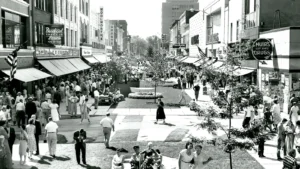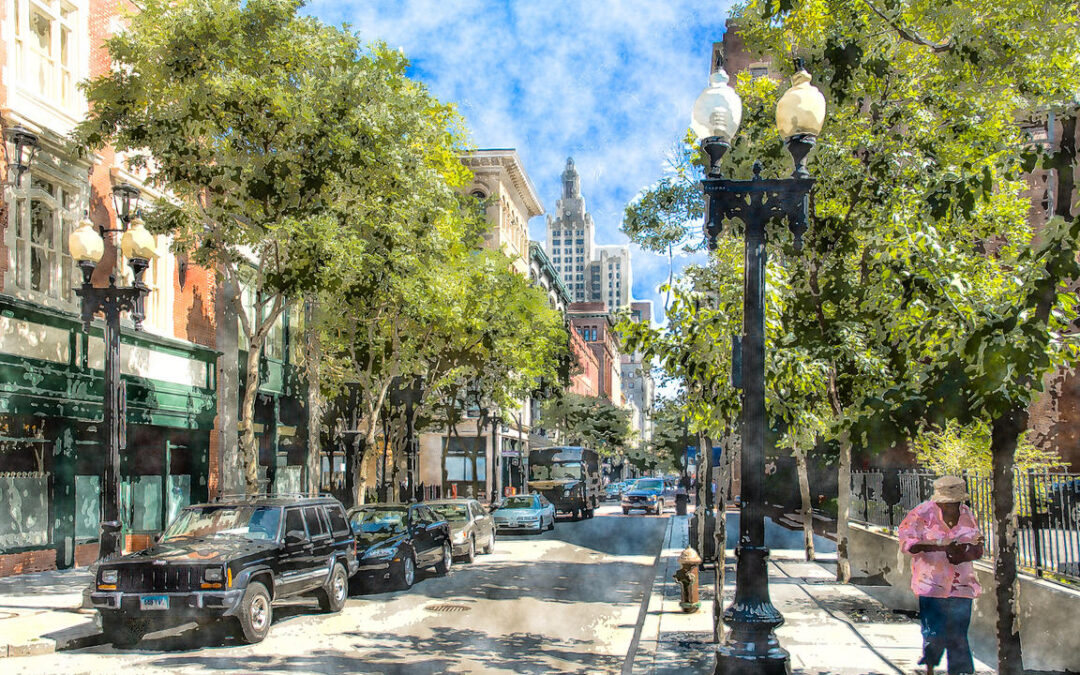Pedestrian malls are areas of a city or town where cars are not allowed and pedestrians have free rein. Pedestrian malls became popular in the United States during the 1960s and 1970s as a way to try to revitalize downtown areas that were struggling due to suburbanization and the rise of automobile culture. However, despite their initial popularity (particularly in temperate places like California), 82% of all pedestrian malls eventually fell out of favor and have been removed or modified since their construction.

Nation’s first pedestrian mall in Kalamazoo, Michigan.
The history of pedestrian malls in the US can be traced back to the post-World War II era when urban areas were experiencing a decline in population and economic activity. Many people were moving to the suburbs, and the increase in the highway system and the rise of automobile ownership made it far easier for them to do so. As a result, downtown areas were left behind economically, as shopping malls and other suburban developments sprang up.
In an effort to compete with these new developments, many cities began experimenting with pedestrian malls. The first pedestrian mall in the US was built in Kalamazoo, Michigan in 1959, and other cities soon followed suit. In the 1970s, the pedestrian mall movement reached its peak, with dozens of cities across the country creating car-free zones in their downtown areas. The rise of the pedestrian mall was driven by several factors. One was a desire to create a more pedestrian-friendly environment in downtown areas that had become dominated by cars. Pedestrian malls were seen as a way to make downtown areas more welcoming to shoppers who had become accustomed to the one-stop convenience of suburban mall developments. Many also strived to create a sense of activity and vibrancy in areas that had become deteriorated and desolate.
Another factor that helped drive the popularity of pedestrian malls was a desire to compete with suburban shopping centers. Many downtown areas were losing business to suburban malls, and pedestrian malls were seen as a way to create a unique shopping experience that couldn’t be found in the suburbs. One reason for this was that they were often poorly planned and implemented. Many cities simply closed off a section of downtown without considering the impact on traffic flow, parking, or access for delivery trucks and emergency vehicles.
The construction of pedestrian malls in northern climates also failed to take into account the short days and cold winters. Pedestrian areas became deserted at these times and actually felt less safe than traditional urban street retail, where passing vehicles offered a sense of safety. The lack of cars meant that there were fewer “eyes on the street,” which made some people feel uncomfortable. Without the bustle of car traffic, many pedestrian malls felt lonely, deserted and dangerous.
Another reason for the decline of pedestrian malls was the rise of online shopping. As more people began shopping online, there was less need for traditional brick-and-mortar stores, and many downtown areas struggled to compete. In response to these challenges, many cities began to modify or remove their pedestrian malls. Some added bike lanes or allowed limited car access, while others simply reopened the streets to cars. Today, there are still a few pedestrian malls in operation in the US, but they are far less common than they were in the 1970s.

Westminster Street in Providence, RI
An example of a pedestrian mall that has been successfully returned to a more traditional multi-modal street is Westminster Street in Providence. Originally closed to traffic in the 1960s as a last-ditch effort to compete with suburban retail centers the “Westminster Mall” was anchored by Shepards department store. However, when this store was sold and its assets liquidated, the district was returned to the more traditional “Main Street Model” of rail and now flourishes in a revitalized downtown district.

A4 Architecture Design for Long Wharf – Newport, RI
Similarly, a pedestrian mall called “The Shops at Long Wharf” was created in 1968 in Newport as part of an urban clearance project when America’s Cup Boulevard was constructed to bring traffic from the nearly constructed Pell Bridge into the center of Newport. Both the urban clearance that demolished many historic structures and the four-lane highway, which nearly cut off the waterfront piers from the rest of the historic city have long been recognized as urban design mistakes. Now, with A4 Architecture’s design guidance and input, the Newport pedestrian mall is also being reconsidered for renovation but with the benefit of fifty years of experience and perspective. Fortunately, much of Newport was designed and built long before the Urban Clearance model of development and has therefore remained an active and vital city and has become, in the last twenty years, one of the most desirable tourist destinations in New England.
By retuning limited traffic to the center, the design will help alleviate traffic confusion that exists from the current design, restore activity and safety to the area at times when it needs it most, integrate the principles of “Green Complete Streets” to the area and restore a historic street that was once the primary connector streets between the town center and the working waterfront. Newport is a city that is one of the most intact, historic places in America, with nearly fifty National Historic Landmarks, the highest designation granted, located within a half mile of this location, which is one of the greatest concentrations of important structures anywhere in the United States. Stay tuned to learn more and also support the restoration of this historic location right in the middle of the community!
Ross Cann, RA, AIA, LEED AP, is an author, historian, and practicing architect living and working in Newport, RI. He holds degrees with honor in Architecture from Yale, Cambridge, and Columbia Universities.
At A4 Architecture + Planning we are expert at integrating advanced retail principles into our urban and building designs to provide more successful solutions for our clients. If you are interested in learning more about what we can do for you, please reach out to us!
